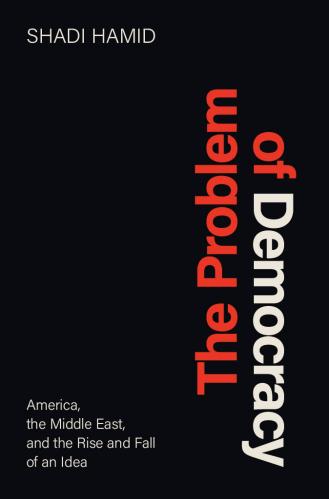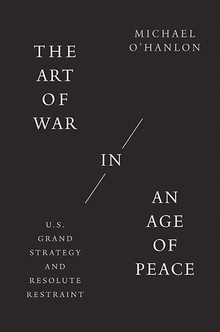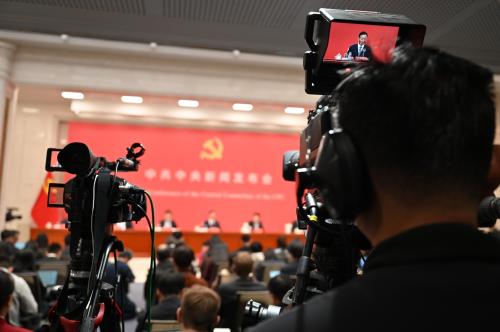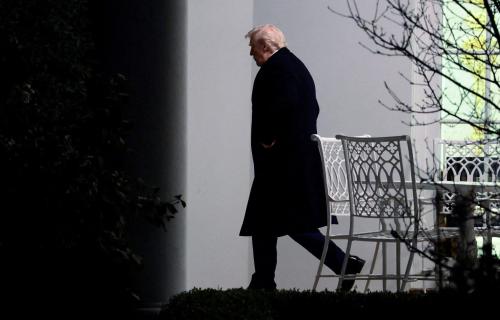On October 12, 2022, U.S. President Joe Biden’s administration released the 2022 National Security Strategy (NSS). Brookings experts reflect on the document and what it reveals about the United States’ security trajectory.
 Shadi Hamid (@shadihamid)
Shadi Hamid (@shadihamid)
Senior Fellow, Center for Middle East Policy
It is little surprise that the NSS has a lot to say about democracy in theory as well as practice. The long struggle between democracies and autocracies, as systems of government, has become the distinctive mark of Biden’s foreign policy.
In the past, I have been critical of the administration’s tendency to instrumentalize democracy by suggesting that its strength and value hinges on its ability to produce “good” outcomes. As I argue in “The Problem of Democracy“, this way of thinking about the democratic idea can easily lead to incoherence. Policymakers have little choice but to be incoherent, some of the time; the world is complicated. Still, identifying these tensions is worthwhile, in anticipation of when they might cause problems for U.S. foreign policy. In this case, they almost certainly will, because they already have.
The NSS says, for example, that “many non-democracies join the world’s democracies in foreswearing these behaviors.” The behaviors in question include “waging or preparing for wars of aggression, actively undermining the democratic political processes of other countries [and] leveraging technology and supply chains for coercion.” The strategy singles out Russia and China as countries that do not forswear such behaviors. But the reason they don’t is related to the fact that they are non-democracies. Either regime type is relevant, or it’s not.
The incoherence is most striking in the Middle East section, which calls for “a more integrated Middle East that empowers our allies and partners will advance regional peace and prosperity, while reducing the resource demands the region makes on the United States over the long term.” Our Arab allies and partners are among the world’s most repressive regimes, so how might empowering them fit into Biden’s insight into the relevance of regime type? To put a finer point on it, the NSS’s discussion of the Middle East seems to contradict — or, at best, lie in direct tension — with much of the rest of the document.
One might take issue with my assessment and highlight Arab non-democracies as the good ones that forswear the aggressive behaviors listed above. But even this wouldn’t be accurate. Two of our closest allies in the region — Saudi Arabia and the United Arab Emirates — wage wars of aggression (Yemen), actively undermine democratic processes in other countries (Tunisia, Egypt), and leverage technology or supply chains for coercion. Again, the reasons are instructive. It is in the nature of authoritarian regimes, when they are regionally dominant, to undermine democratic processes elsewhere in the region. The mere existence of democratic counter-models offers up a constant reminder that another way is possible. And, for such regimes, another way is not possible.
These days, the Middle East is easily dismissed as a distraction. But, as far as regions go, it remains a laboratory for the contradictions at the heart of American policy. To the extent that a “democracy-first” strategy is an organizing principle in the confrontation with China and Russia, U.S. administrations will — sooner or later — have little choice but to reckon with the realities of the world’s most undemocratic region. If organizing principles are only relevant when they are convenient or serve a particular purpose, then they’re not exactly organizing principles.
 Daniel S. Hamilton (@DanSHamilton)
Daniel S. Hamilton (@DanSHamilton)
Nonresident Senior Fellow, Center on the United States and Europe
The NSS clearly articulates U.S. values and interests in a new age of disruption, and offers a compelling strategy for protecting and advancing them. It addresses China’s challenges and Russia’s threats without conflating them, as previous strategies have done. It frames these state-centric tests within a context of growing transnational challenges that the United States will be unable to address alone. It is a sober yet confident strategy that builds on the ingenuity and resilience of the American people, the unique strengths of our oft-maligned democracy, and the capacities offered by our vast and unparalleled networks of alliances and partnerships, reinforced by agile diplomacy and a strong military.
The strategy underscores how U.S. interests are threatened by those who weaponize the interdependencies that were created during the now-bygone post-Cold War era. The United States and our like-minded allies and partners have long been accustomed to protecting our territories. We must now be equally focused on protecting our connectedness – the values that bind us and the critical flows of goods, services, energy, people, and technology that underpin our security and well-being. This is not a strategy of decoupling; it is a strategy to redefine the terms of our interdependence in a competitive and dangerous world. In this new age of disruption, our national security rests on our resilience – as a society, as a partner and ally, and as a global power.
 Ryan Hass (@ryanl_hass)
Ryan Hass (@ryanl_hass)
Senior Fellow, Center for East Asia Policy Studies and John L. Thornton China Center
Whereas the 2017 National Security Strategy treated China and Russia as an interchangeable threat to America’s security and prosperity, this strategy draws distinctions between them. This NSS clarifies that Russia and the People’s Republic of China (PRC) “pose different challenges” that demand differentiated responses. The NSS explains that the United States “will prioritize maintaining an enduring competitive edge over the PRC while constraining a still profoundly dangerous Russia.”
This shift in how the United States views China and Russia is subtle but significant. It suggests the United States has opted against embracing fatalistic conclusions that nothing can be done to affect the China-Russia relationship and that the United States must simply gird for ideologically infused bloc confrontation. The Biden administration was wise to reject such oversimplified analysis. There is no profit for the United States to treat China and Russia as interchangeable foes. If it did so, Washington would find few followers.
To be sure, the United States’ relationship with both countries will remain confrontational for the foreseeable future. The China-Russia relationship is animated by shared antagonism against the United States. There is virtually no chance the United States will drive a wedge between China and Russia, as it did during the Cold War.
At the same time, painting China and Russia with black and white brushes obscures that those countries do not have perfectly aligned interests. Russia is more of an arsonist of the existing international order, whereas China seeks to be an architect of a revised order. China and Russia have different perspectives on Central Asia and the Arctic. Since China is still rising while Russia is not, Beijing has more to lose and hold at risk than Moscow. Recognizing such distinctions is a critical step toward crafting approaches to act upon them.
 Bruce Jones (@BruceBrookings)
Bruce Jones (@BruceBrookings)
Senior Fellow and Director, Project on International Order and Strategy
The new NSS puts to rest the least edifying debate in Washington: Should geopolitics or transnational threats primarily pre-occupy U.S. foreign policy? The obvious answer, decisively rendered here, is both. There’s no escaping the reality of great power contestation, and the strategy embraces it. But there’s also no escaping the fact that American lives have been profoundly shaken by transnational challenges. The NSS kicks off a needed debate, too, about how to sustain some type of cooperation against shared challenges while contesting vigorously in the strategic domain. But as Chrystia Freeland reminded us in her barn raiser of a speech on October 11, in the Cold War we know how to both contain and engage; time to re-learn that lesson.
The NSS also takes U.S. strategy to a better place in diplomacy, putting the president’s emphasis on the democracy/autocracy divide in a wider context. The text — and even more so, U.S. National Security Adviser Jake Sullivan in his launch speech — makes clear that the United States will work with any state, of whatever regime type, that is willing to work within the framework of the key treaties of the order, especially the U.N. Charter, including China when that is in our interests. Engaging in that way will put us in a stronger position when push comes to shove — as it likely will, in one form or another — and we need to rally support to push back, when China or Russia or others engage in more pernicious behavior.
 Patricia M. Kim (@patricia_m_kim)
Patricia M. Kim (@patricia_m_kim)
David M. Rubenstein Fellow, John L. Thornton China Center and Center for East Asia Policy Studies
The 2022 NSS reinforces key themes that have been consistently emphasized throughout the Biden administration — strengthening the United States at home, aligning with like-minded partners, and competing responsibly with China to advance U.S. interests and its vision of a “free, open, secure and prosperous world.” It wisely makes the case the United States must pursue a “dual-track approach” that involves working with both like-minded allies and partners, as well as geopolitical rivals, to address the many global challenges, from climate change to food insecurity, that pose an existential threat to all.
Laudably, the NSS directly confronts the sheer challenge of advancing cooperation among great powers on transnational threats in an era of heightened geopolitical competition. While making clear that the United States rejects China’s attempts to link cooperation on shared challenges to concessions in other areas, the document does not offer any answers on how, then, Washington will actively spur Beijing’s constructive contributions and unlock a “race to the top,” as the NSS puts it.
To be fair, these are extremely difficult questions to answer, and the document sets low, if realistic, expectations for the bilateral relationship with China. The NSS concludes that the United States government will “continually assess and reassess our approach” in the implementation of the strategy, which is a welcome statement as it will be critical to grasp for more imaginative roadmaps, be it with rivals or less like-minded counterparts, to secure the foundations for a more stable and prosperous future in this “decisive decade.”
 SUZANNE MALONEY (@MaloneySuzanne)
SUZANNE MALONEY (@MaloneySuzanne)
Vice President and Director, Foreign Policy
The long-awaited public release of the NSS contained no real surprises, arriving as it did well after the scaffolding of the administration’s approach to the world had been made tangible over the course of the first half of Biden’s term in office. With an emphasis on the essential synergies between America’s strength at home and on the world stage, the NSS showcases the administration’s industrious track record of initiatives to make progress on both fronts. And it offers a compelling narrative that seeks to reaffirm the president’s stirring rhetoric around the contest between democracy and authoritarianism as the foremost challenge of our times without handcuffing the U.S. policy with intractable Manichaeism or instigating a new Cold War.
However, as with any articulation of strategy, the document inevitably elides the messy tradeoffs inherent in advancing core U.S. interests. As has already been evident, Biden’s stirring rhetoric faces real world complications in its implementation – how to balance the urgent (Russia) with the essential (China); how to build multilateral coalitions that are both “inclusive” and effective; how to counter Beijing’s military and economic aggression while preserving capacity for cooperation around the global commons, especially the climate crisis; and how to strengthen democracy at home and abroad even as the forces threatening these values are amplifying.
This is one of several reasons why the document’s short shrift on the Middle East, while understandable, seems particularly unfortunate. If there is one region where the best of intentions and an enormous investment of strategic energy and resources has come up short in advancing our values or durably securing our stated interests, it is there – in large part due to our disregard of the yawning chasm between our rhetoric and the reality. The NSS is right to decisively draw an end to the 9/11 era, but a reckoning with our own track record will be essential to prevailing in addressing the even more daunting challenges of strategic competition.
 Amy J. Nelson (@amyjnelsonphd)
Amy J. Nelson (@amyjnelsonphd)
David M. Rubenstein Fellow, Strobe Talbott Center for Security, Strategy, and Technology
The NSS reflects an approach to national security that is increasingly inclusive of non-defense factors. It also really amplifies the role of technology in national security, and is particularly notable for its integration of foreign policy with technology policy. The result is an approach that is consistent with the notion that foreign policy and tech policy are increasingly one and the same.
On emerging tech, the NSS calls out its transformational effect on warfare, and the need to invest in technologies for cyber, space, missile defense, AI, and quantum. Importantly, it notes that security requires new tech to be delivered quickly — an age-old struggle for the Department of Defense. Historically, innovating tech and protecting have lived in separate spheres. Because they actually go hand-in-hand, it was good to also see the intent to continue to evolve the U.S. approach to strategic trade controls to protect sensitive technologies and maintain technological superiority and advantage.
The NSS also discusses the role of allies and partners in implementing the strategy at length, leaning heavily on collective action through multilateral partnerships. It notes, for example, the “connective tissue — on technology, trade and security — between our democratic allies and partners” and the “allied techno-industrial base.” This amounts to perhaps a renewal of ties that had frayed under the previous administration, a doubling down on the proliferation of “minilaterals” as strategy, and, critically, the acknowledgement that national security requires technology cooperation among allies.
Also striking is the repeated mention of the word “competition” (44 times) — as if the post-Cold War era is being replaced by one predominantly characterized by a pervasive and unavoidable competition: “We will use impulses released by an era of competition to create a race to the top and make progress on shared challenges.” In this way, competition is described as an unavoidable force that will continue to drive behaviors and shape outcomes. Competition is linked to pervasive technology and its innovation: “Competition to develop and deploy foundational technologies that will transform our security and economy is intensifying.” And competition is again discussed in the context of allies: even among allies, we will experience competition. In this way, the NSS seems to note the implicit tension between the need to work together with allies and partners, pooling “technical expertise and complementary industrial capacity,” while in an era of competition. And this will be a major challenge for decades to come.
 Michael E. O’Hanlon (@MichaelEOHanlon)
Michael E. O’Hanlon (@MichaelEOHanlon)
Senior Fellow and Director, Strobe Talbott Center for Security, Strategy, and Technology
Given that I have recently written a fairly positive assessment of the administration’s achievements to date, I will content myself in this short blog with several specific critiques of what is otherwise a solid (if acronym-laden) document. Specifically:
- The elevation of China as our top national security concern seems incongruous with the reality that Russia is waging a hot war and making nuclear threats on the other side of the planet. Although the language used to describe China is carefully chosen, and muted — it is a “pacing challenge,” or our “most consequential strategic competitor” according to the NSS — one cannot help but walk away with the sense the administration views China as public enemy number one. To me this is wrongheaded. China wants to bend the existing global order in a direction it desires, but unlike Russia it does not generally seek to break it, and the distinction is important.
- The specific accusation that China is committing genocide against the Uighurs of Xinjiang province is also a mistake. I don’t care what the State Department lawyers say: What China is doing there is plenty bad, but it is not genocide. That loaded and inflammatory term has a powerful historic meaning and whatever the PRC’s other flaws, it is not currently guilty of genocide. We need to stay cool in handling this relationship and avoid pushing Beijing closer to Moscow unnecessarily.
- Sullivan emphasized in his discussion at Georgetown University on October 12 that we mean no ill will against the Chinese people; our beef is with the PRC government. That is a reasonable point, but it implies that the Chinese people do not share their government’s views on key issues. In fact, however, the Chinese people are themselves nationalistic, and they are themselves insistent that Taiwan is part of China, so it would be wrong to view the current government in Beijing as somehow an outlier on many of the key issues that create discord in the U.S.-China relationship.
- North Korea policy remains too purist. We are not going to negotiate complete nuclear disarmament with Pyongyang anytime soon; we need a more serious and incremental strategy that seeks to verifiably dismantle North Korea’s nuclear production capacity and ban future nuclear as well as intercontinental ballistic missile tests in exchange for a partial lifting of sanctions and caps on the size of U.S.-South Korean military exercises. To stay on the current course is simply making the problem worse (as Pyongyang keeps building and testing weapons) and risking another major crisis (we can closer to war in 2017, as well as 1994, than many realize).
- Latin America remains close to an afterthought at a time when the opioid crisis is killing 100,000 Americans a year, largely due to drugs coming over the southern border, and when immigration and crime and border issues remain hugely divisive in American politics. The administration needs a big idea akin to a Marshall Plan (or, at a minimum, something on the scale of former U.S. President George W. Bush’s PEPFAR initiative on AIDS) for Central America and Mexico.
 Natan Sachs (@natansachs)
Natan Sachs (@natansachs)
Senior Fellow and Director, Center for Middle East Policy
The NSS is an ambitious and impressive articulation of a new era of American foreign policy. The Middle East is an uneasy fit: It was the central theater of the past, not the present, and it strains the democracy-themed world order Biden envisions. The NSS thus tries to thread a needle: “The most pressing strategic challenge…” is not from autocracies, per se, but “from powers that layer authoritarian governance with a revisionist foreign policy.” This leaves the door open to partnerships with autocracies if they “subscribe to the rules-based international order.”
The NSS articulates “a new framework” for Middle East policy. It emphasizes freedom of maritime navigation (implying energy supplies), coalition building and diplomacy (an attempted return to the Obama-era Joint Comprehensive Plan of Action). It stresses military deterrence — primarily against Iran — but eschews the military-based approaches of the past (read: Bush 43). It embraces regional integration (invoking the Trump-era Abraham Accords and further efforts under Biden, including the India-Israel-UAE-U.S. quad, aka “I2-U2”, that is still in search of substance). It breaks clearly with former U.S. President Donald Trump in a rhetorical commitment to “promote human rights” and in calling for an Israeli-Palestinian two-state solution “along the 1967 lines, with mutually agreed swaps,” a far cry from the Trump plan.
The new framework for Middle East policy is thus appropriately modest: “It is time to eschew grand designs in favor of more practical steps”. As a secondary theater, the Middle East is now meant to fit into a broader global agenda, rather than dominate it.
 BRUCE RIEDEL
BRUCE RIEDEL
Senior Fellow, Center for Middle East Policy and Strobe Talbott Center for Security, Strategy, and Technology, and Director, The Intelligence Project
Biden’s new national security strategy faces an immediate and urgent challenge in the Middle East. America’s oldest ally in the region, Saudi Arabia, has opted to support Russia in its invasion of Ukraine by dramatically cutting oil production to raise prices which benefits Moscow. Since the president unwisely journeyed in July to Jidda to embrace Saudi Crown Prince Mohammed bin Salman, known as MBS, the Saudis have also dramatically stepped up repression of domestic critics, especially women.
So Saudi Arabia fragrantly violates the human rights provision of the new strategy and partners with Russia against NATO. MBS’s closest Arab partner, President and Crown Prince of the United Arab Emirates Muhammed bin Zayd, has just traveled to Moscow to support Russian President Vladimir Putin in person. The Saudis and Emiratis have backed the loser in the war enthusiastically.
So the administration has to show it intends to live up to its promise to support human rights and democratic states against autocratic regimes. It should immediately suspend military cooperation with the kingdom and halt provision of spare parts to the Saudi military. It should rally our NATO allies including Britain and France to do the same. American military forces in the kingdom should be redeployed to Qatar.
The Saudis are led today by a reckless and dangerous prince whom the president rightly said two years ago should be treated as a global pariah. The new strategy is being challenged by that prince, and the administration needs to fight back.
 Melanie W. Sisson (@MWSBrookingsFP)
Melanie W. Sisson (@MWSBrookingsFP)
Fellow, Strobe Talbott Center for Security, Strategy, and Technology
Reading the Biden-Harris administration’s 2022 NSS calls to mind the advice famously dispensed by Coco Chanel: “Before you leave the house, look in the mirror and take one thing off.” In this case, it’s the many criticisms of China – which range from oblique references to unnamed autocracies that “abuse the global economic order” to specific opprobrium of China’s “unwillingness to cooperate” with the international response to COVID-19 and “genocide…in Xinjiang” – that distract the eye from the strategy’s considerable strengths. These inclusions interrupt the overall message, which is that the administration (rightly) is focused on what the United States needs to do at home – invest in the enablers of human security, talent, and productivity – to be able to do what it wants abroad: create conditions that are conducive to the global movement of people, ideas, investments, and goods, and that disincentivize governments from using violence to pursue their national interests.
So too does delivering these demerits in the administration’s marquee document provide Beijing yet more fodder with which to reinforce its narrative that the United States unfairly, and zealously, seeks to contain, constrain, and suppress China. While the administration’s intent may be to draw an explanatory and compelling contrast between the two nations’ visions for international relations, the effect is an unhelpful dilution of its affirmative, pragmatic message and an avoidable addition to China’s negative one.
 Mireya Solís (@solis_msolis)
Mireya Solís (@solis_msolis)
Senior Fellow and Director, Center for East Asia Policy Studies
The NSS is rightly focused on the need to shape the rules of the road on trade and technology, and recognizes that the U.S. must work with allies and partners to achieve these objectives. It is wise in calling for robust competition with China while leaving room for cooperation on transnational issues. But pairing this strategy document with recent developments on economic diplomacy and export controls underscores some inconsistencies, a potential mismatch between goals and policy tools, and a strong vein of unilateralism that will irk some of our “like-minded” partners.
The NSS seems to be of two minds when it comes to the benefits of globalization, touting the increased prosperity it has delivered at home and abroad, while also blaming it for the harms caused to American workers and the environment. It asserts the need to leave behind traditional trade agreements (which have been anchored on trade liberalization) while showing no awareness that our partners and competitors in the Indo-Pacific continue to see free trade agreements as powerful tools to promote trade and codify new economic rules.
Time will tell whether the Indo-Pacific Economic Framework can deliver on the rulemaking ambitions of the Biden administration, but color me skeptical that it will secure ambitious and enforceable labor and environmental commitments from our counterparts in the absence of market access benefits.
A few days before the release of the NSS, the Biden team dramatically redefined technology competition with China. The strictest export controls to date will curtail China’s access to advanced chips in supercomputing and AI. Notably, they are unilateral measures to be applied extraterritorially. Many of our Asian partners have embraced economic security to protect against technology leaks, eliminate infrastructure vulnerabilities, and boost supply chain resilience. But they may balk at the implications of following up with export controls geared at stalling China’s technological development.
 CONSTANZE STELZENMÜLLER (@ConStelz)
CONSTANZE STELZENMÜLLER (@ConStelz)
Senior Fellow and Director, Center on the United States and Europe and Fritz Stern Chair on Germany and trans-Atlantic Relations
For Europeans, there is much to like, to respect, and to work with in the Biden administration’s sober and nuanced new national security strategy. Despite endorsing the strategic competition framing of its 2018 predecessor document, it emphasizes the need for cooperation — even with autocrats and adversaries — on global challenges and public goods. It is reassuringly tough on Russia. Even more remarkably, it is both clear-eyed about China’s intent to reshape global order to its liking, and moderate in offering to work together with Beijing on issues of common concern. It acknowledges the importance of democratic allies as essential leverage for American strategic purposes; but it rejects messianic advocacy of democratic transformation and promises repeatedly to work with non-aligned countries that do not share the West’s vision. Despite the United States’ unquestioned leadership in the conflict with the Kremlin, it highlights Europe’s contribution “at the front lines” of the fight to defend Ukraine; and it calls the European Union an “indispensable partner.”
Critics of America — especially in Germany — might note the document’s explicit rejection of some of their favorite strawmen (decoupling from China, bloc-building, a new Cold War). But above all, Europeans should take to heart its strong tone of urgency (“we are in the early years of a decisive decade for America and the world”). The midterm elections may well reinforce that note.
 Andrew Yeo (@AndrewIYeo)
Andrew Yeo (@AndrewIYeo)
Senior Fellow, Center for East Asia Policy Studies and SK-Korea Foundation Chair in Korean Studies
The NSS is bold and ambitious in its aim to protect a “free, open, prosperous, and secure world.” But can the United States sustain international order if it remains preoccupied with “out-competing” China?
Competition emerges as a dominant theme throughout the 2022 NSS. Terms such as competition(s), competitor(s), and compete(s) appear no less than 25, 21, and 15 times, respectively. In contrast, cooperation, cooperate, and collaboration/collaborate appear 19, five, and five times, respectively. Including “partnership(s)” adds an additional 18 words.
The Biden administration clearly believes the United States must gear up for serious competition with adversaries in the next decade. The NSS fact sheet also acknowledges the a priori nature of competition, declaring, “We cannot compete successfully to shape the international order unless we have an affirmative plan to tackle shared challenges, and we cannot do that unless we recognize how heightened competition affects cooperation and act accordingly.”
The United States should take a strong stand against actors wishing to undermine a free and open order. However, there is a danger in overselling competition against China. It may unnecessarily create blind spots for opportunities of engagement with China and other adversaries. It can also spook potential partners who may choose to stay on the sidelines rather than become embroiled in zero-sum competition. Finally, it may ultimately harden the lines of a growing bifurcated global order and undermine the inclusive form of governance that is needed to address future problems confronting all of humanity: climate change, pandemics, and nuclear non-proliferation.
The Brookings Institution is committed to quality, independence, and impact.
We are supported by a diverse array of funders. In line with our values and policies, each Brookings publication represents the sole views of its author(s).























Commentary
Around the Halls: Assessing the 2022 National Security Strategy
October 14, 2022